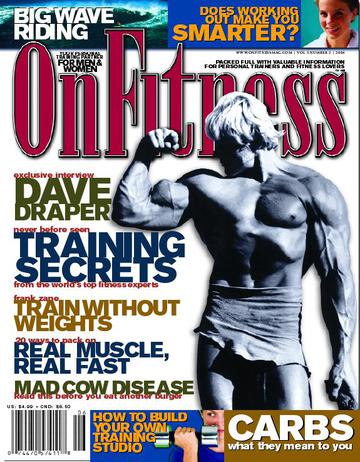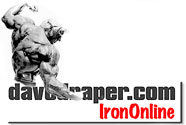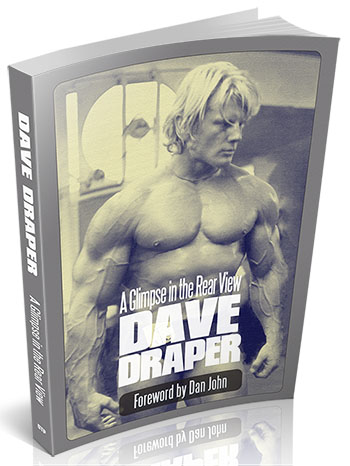The OnFitness Interview, Part Two

Download the full Draper here newsletter
in printable, live-link, pdf format, here.
We continue with the second part of this older OnFitness interview. If you missed it last week, Part One is here.
Q) What are your feelings about competitive bodybuilding today? Is this healthy and are the supplement companies behind this, pushing their products for profit at any cost?
It’s an extreme world supporting extreme sports, and bodybuilding has not been spared. As such, it’s truly remarkable what the top participants are able to do if they’re willing and committed. Various drugs have been added to the equation in many professional sports, and we’re hearing loud noises in the locker rooms and the media and law enforcement. Greatness comes at a cost and the price has been raised with the technology of the times.
I’m not brokenhearted to have missed direct participation by a year or two or 35. It’s different than my era, and most people think it’s gotten out of hand. They agree that symmetry, individual distinction and reasonable sanity have given way to monster size, all-body similarity and wackiness.
There are numerous dynamics at work in the chaos. The consumer defines the market and the market defines the consumer. It’s the chicken and the egg thing.
Money rules. The bottom line is the driving force. The product hype is staggering. Magazine advertisers, TV infomercials and across-the-web scammers make a lot of noise and claims and money and create disillusioned, disappointed consumers. Eventually folks become savvy, endure the hype and move on. It’s part of growing up in the real world. The survivors outlive the commercial world and build relatively strong and healthy bodies.
But, there are merchants who don’t submit to the big-business mentality and methodology. They offer solid advice and worthwhile products. These small companies surface like corks in a pond and you have to stop, look and listen to find them. There’s plenty of help for the discerning and persistent musclebuilder. It’s not all bad and the good there is, is terrific.
Q) What modality of lifting did you use when preparing yourself for contests?
My routine would remain some variation of the basic bar, dumbbell and cable movements, hitting each muscle group (usually four different exercises per bodypart, five sets of 4 to 12 reps of each), twice a week over a six-day week.
At eight weeks out, I’d lighten the weights used in each exercise, superset, be precise in form, gear up my training pace and increase the contraction of each rep. I’d tune in my training and exercise choices daily to accommodate my muscle-working needs -- urges, body feelings and instincts would guide me here. I’d rest and relax more, and stress less to ensure repair and well-being.
I’d tighten my already good eating plan by removing milk products during the last month, lower the carbs to just salads, and increase my fish intake as I sought calorie reorganization. Thus, I’d sustain an anabolic environment with high protein and sufficient carbs and good fats, being certain I didn’t sacrifice energy and muscle in the quest of fat loss and definition. To this I’d add little or no salt, lottsa water, the usual vitamins and minerals, amino acids and positive thinking and visualizing, hope and prayer.
Q) I love your philosophy of “train hard, eat right and be happy!” What nutrition advice can you give to our readers?
Nutrition is an interesting and complex subject, yet what we need to know as lifters is simple and forthright. Keep it simple. Why tangle with the subject unless it absolutely fascinates you? Even then, don’t expect knowledge to take the place of hard work, discipline, consistency and common sense. There are no secrets, shortcuts or easy ways to gain fitness, lose fat and gain muscle size, strength and definition. We only have the true, challenging and fun way: train hard, eat right and be strong, and be happy, and be positive, and be good.
Be consistent, patient and certain.
Q) What do you prefer, free weights or machines? Is one safer than the other?
I prefer free weights if I had to choose only one modality. As it is, I find cables important for the effective engagement of a variety of muscle groups, and as I get older I find myself using cables more. I like pulldowns for lats, seated cable rows for back, cable crossovers for pecs, pushdowns for tris.
Machines come into play as comfortable alternatives when limited by injury, isolating a muscle group or for a change of pace. As they follow a designated groove, they’re limited in muscle recruitment, yet provide protection and direction for the novice and the under-trained, like training wheels for the junior bicyclist. Some machines are more useful than others; some are no use at all.
Q) In your opinion, what is the most dangerous information being taught today?
This stuff comes in waves. Crazy, mad techniques come from the gyms and garages of the diehards, and die hard they do. For the healthy fitness seeker and well-balanced musclebuilder, I think weight training is straightforward work, sets and reps, logical body movement and intensity of output that matches one’s personality.
There are some who have the notion that training furiously for 30 minutes every seventh to tenth day (whatever) is the true way of the real champion iron-and-steel muscle builder. Monster weight times monster reps equals monster muscles and power; keep the pail and smelling salts handy.
I don’t know. I scratch my head and wonder, “Do they like to train; do their joints operate freely; can they do this forever?”
Train hard but not suicidal; push but don’t punish; exceed but don’t bleed; bomb it but don’t vomit.
Q) When asked about the one thing you would change about mainstream fitness, you replied, “The accent on aerobics.” Can you please elaborate on this?
Aerobic exercise has been over-emphasized, a symptom of the run-and-get-fit mentality that broke out like hives in the ’70s. “Run, my child. It is the answer.” It was written and everyone believed.
In quick response, the Main Street assembly lines began turning out treadmills and stationary bikes like they were Model Ts. We walk, we run… how about climbing? Stairmasters are for you. Wait, there’s more. Elliptical trainers, recumbent bikes, rowers and rooms packed with aerobic dancers.
All other exercise -- namely, the weights -- was shifted to the back of the gym, and people preferably ran their pants off while they watched TV and read People Magazine, or they danced like cheerleaders.
In time, the heart and lungs came out on top, some fat was lost and no overall muscles were built… no strength, little discipline, no creativity. Each year a new model cardio machine came out like another BMW. The manufacturers grew rich and the users, for the most part already lacking in commitment and discipline, were misdirected, mislead, convinced of a half-truth and disappointed.
I’m not partial; I’m professional. Some cardio is good, too much is too much and the benefits the activity promises are an exaggeration, a misconception, and a self-elaborated deception. A person wants to believe it works ’cuz “they” said so and it’s simple, easy and hopeful.
Ordinary people who want to build muscle, lose fat and get in shape need at least 80 percent hardy resistance training (it’s wonderful) and maybe 20 percent high-intensity interval training. And they need to eat right, and they need be consistent, positive and motivated.
Q) What advise can you give personal trainers to be the best they can be?
Spend the next 10 years practicing this stuff and go out there with a big heart and a generous spirit and show your clients passionately how it’s done. If you don’t have 10 years, recognize who you are and apply yourself wisely and humbly according to your knowledge and understanding. You’re there to help people help themselves, to teach them to be better than ever. Listen to them, get to know them, appreciate them, ask the right questions and empathize with their situation as well as you can (that’s why experience is so important). Evaluate tand plan a routine that will begin slowly yet deliberately as you continue to observe the personality and needs, and gain their confidence.
Most of all, encourage them and share your good energy. Motivate them and give them hope. Make them work hard in due time. Don’t pamper and thus weaken them -- that’s not good for either of you. Count to 10 only when necessary, and be forgiving but strong.
And, always be honest. Be yourself.
Q) What are some of the most common mistakes you see personal trainers make?
Other than the occasional improper instruction and wrong information, socializing, chatting incessantly, losing focus…too much assistance and too little or too much energy top the list.
I know everyone wants another person’s approval, especially when the other person’s paying, and being exceedingly nice and helpful goes a long way. I’d quickly establish a real and consistent work mode, a crisp and alert training atmosphere to earn the client appreciation. A friendly and professional attitude in itself is commendable and rewarding: work hard, get the job done, understand the process and enjoy the fulfillment. Responsible seriousness can easily be sprinkled with persuasion and encouragement to soften its hard edge, and comic relief is an oasis amid some tough sets and reps.
I’d avoid silliness, chatting too much and any distractions from the wonderful task at hand. No sport talk, no politics and no dirty jokes, and for crying out loud don’t hand them the weights or become their workhorse or minion.
Be strong and in charge. This is weight lifting, not breakfast at Tiffany’s.
There you have it, typos, poor grammar, inanity and all.
*****
Take a trip over to our
Musclebuilding Q&A Blog
... where Dave allows us a peek into his email outbox.
Did you sign up for Dave's expanded email yet?
It's free, motivating and priceless!
We'll also send you a link to Dave's free
Body Revival Tips and Hints e-report with your confirmation notice.

